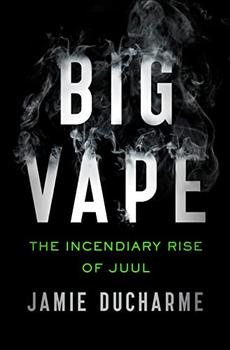Summary | Excerpt | Reviews | Beyond the Book | Readalikes | Genres & Themes | Author Bio

The Incendiary Rise of Juul
by Jamie Ducharme
Pretty soon, Adam and James started talking about their idea at the product design program's Tuesday night workshops, where students could bounce ideas off professors and their classmates. They knew they wanted to create a product that delivered nicotine in a safer way than cigarettes, they knew it would need to be portable and easy to use, and they knew they wanted it to look more interesting than a cigarette, classmate Leys remembers. During a lunchtime brainstorming session with their classmates during which people shouted out ideas and James scribbled the good ones on Post-It Notes and slapped them on the wall, they landed on a name: "Ploom." It had the right ring to it, and it played off the concept of smoking without being too heavy-handed.
Leys says he was intrigued by Ploom's potential health benefits for smokers. Back then, he says, nobody thought too much about the potential downsides of the product—like exposure to new kinds of chemicals or attracting kids—but some of James and Adam's professors were wary of how fast the two were moving. "From an academic point of view, I think it was like, 'Wow, that's cool, but let's try to investigate some of the different options that this could be,'" Leys says. "And I think James and Adam were kind of like, 'Let's drive ahead.'"
They did make at least one concession to their professors' pleas to slow down and do more research. They dug deep into the archive of internal tobacco industry documents made public in part thanks to Stanton Glantz, a tobacco control expert and professor of medicine at the nearby University of California, San Francisco. In 1994, a box full of thousands of confidential tobacco industry documents landed on Glantz's desk, courtesy of an anonymous source identified only as "Mr. Butts." Glantz had heard rumors that other researchers around the country had gotten these documents via an anonymous source, and he'd been hungry to get his hands on them himself. From what he had heard, a paralegal working for the tobacco company Brown and Williamson had begun to grow disturbed over what he was seeing in the company's files. He started sneaking documents home with him at night, copying them, and then returning them the next day. When he had enough compiled, he shared them with "Mr. Butts," who began distributing them to journalists and researchers, including Glantz.
The documents spelled out years of Brown and Williamson's wrongdoings. Company memos, letters, and meeting minutes showed that executives had for years downplayed, or outright lied to the public about, how addictive and dangerous smoking was and had peddled misleading research meant to cast doubt on the idea that cigarettes caused cancer and other health issues. Glantz turned the pages over to UCSF's library for review and publication, hoping that entering the documents into the library's archive would protect them from possible court orders. He and several UCSF colleagues also used the documents to write a book called The Cigarette Papers.
In 1998, attorneys general from forty-six U.S. states, five territories, and the District of Columbia reached a landmark settlement with cigarette companies, including Brown and Williamson, Philip Morris, R.J. Reynolds, and Lorillard. Still the largest civil settlement in U.S. court history, it became known as the Tobacco Master Settlement Agreement. The attorneys general involved successfully argued that because smoking-related disease was a major stressor to the public health care system—and one that Big Tobacco companies had downplayed for years—tobacco makers should reimburse states for some of the money they'd poured into these public aid networks. The Big Tobacco companies agreed to pay out billions of dollars a year for the first five years after the settlement, as well as perpetual annual payments calculated depending on inflation and cigarette sales. Manufacturers also agreed to rein in their marketing, most notably by agreeing not to market to children and teenagers. The American Legacy Foundation (now known as the Truth Initiative), one of the nation's leading antismoking groups, was also born from the settlement. And significantly for Adam and James, documents uncovered during litigation were published openly, so the American public could see and understand exactly what Big Tobacco had been up to all those years.
Excerpted from Big Vape by Jamie Ducharme. Copyright © 2021 by Jamie Ducharme. Excerpted by permission of Henry Holt and Company. All rights reserved. No part of this excerpt may be reproduced or reprinted without permission in writing from the publisher.
Failure is the condiment that gives success its flavor
Click Here to find out who said this, as well as discovering other famous literary quotes!
Your guide toexceptional books
BookBrowse seeks out and recommends the best in contemporary fiction and nonfiction—books that not only engage and entertain but also deepen our understanding of ourselves and the world around us.